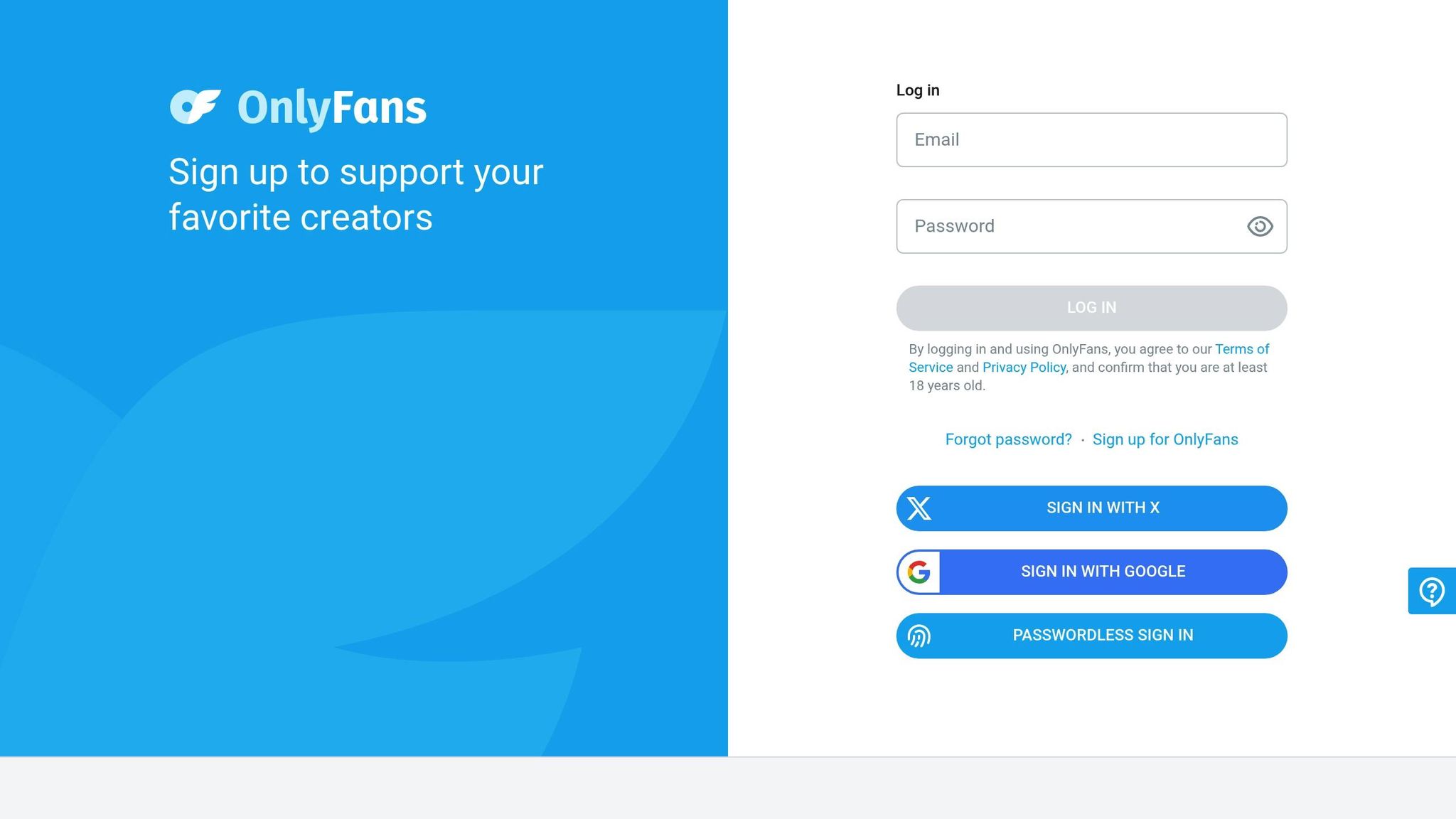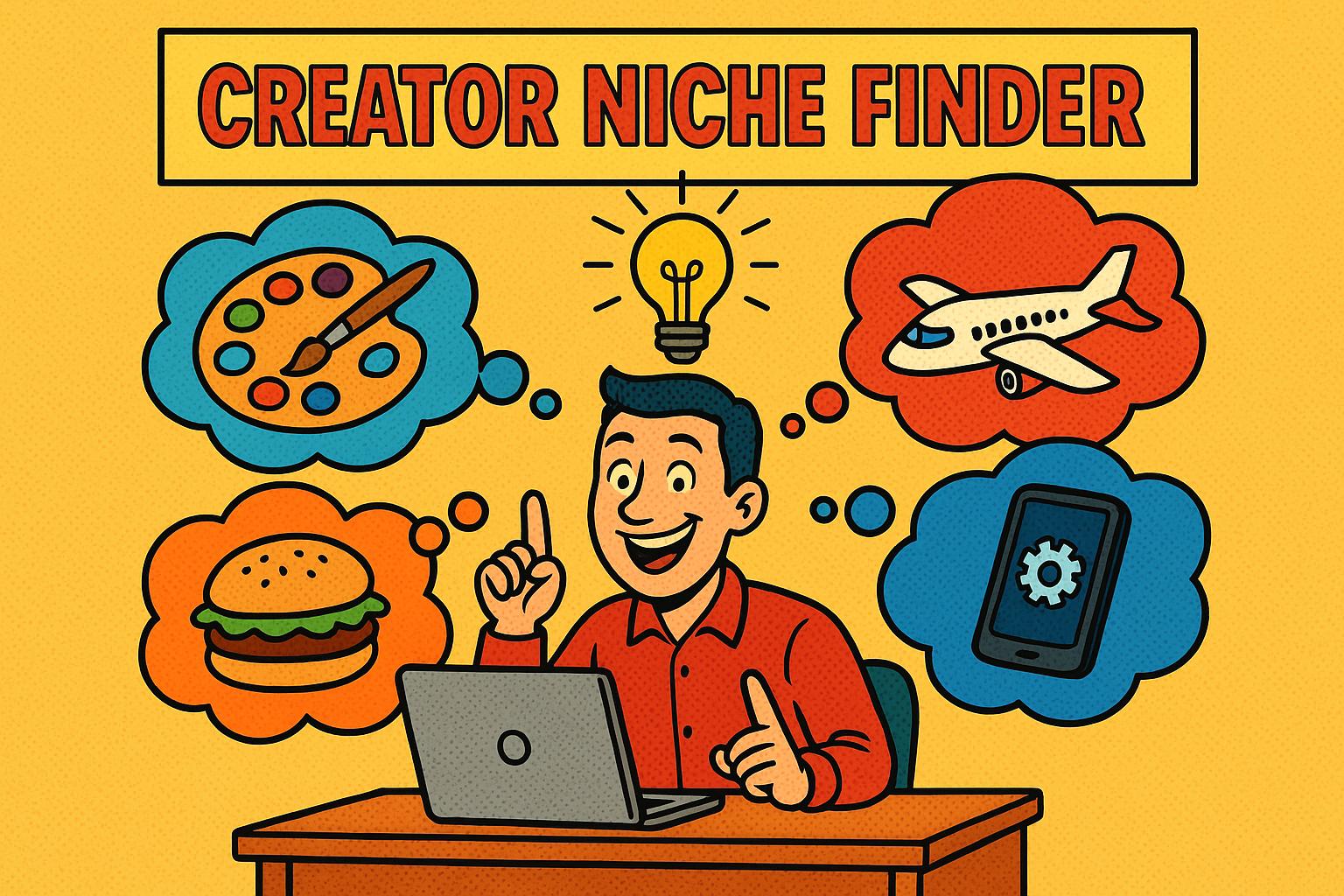The creator economy is exploding, and OnlyFans Management (OFM) agencies are at the center of this growth. With $185 billion in creator revenue projected for 2025, managing creators on platforms like OnlyFans is a lucrative business opportunity. Here’s what you need to know to get started:
Key Takeaways:
- What is an OFM agency? It handles content strategy, fan engagement, and account management for creators, allowing them to focus on creating while you boost their revenue.
- Why now? AI tools and analytics are transforming how agencies operate, making it easier to identify talent, predict trends, and optimize earnings.
- How do OFM agencies make money? They typically take 30-50% of creator revenue, with upselling opportunities like personalized content and fan interactions driving additional income.
- What’s required? Market research, a solid business plan, legal compliance, and the right tools (e.g., NimbusReach, Infloww, and Zapier) are essential for success.
This guide covers everything from finding creators and building relationships to setting up workflows and scaling your agency. Whether you’re starting small or aiming to grow big, the opportunities in 2025 are massive.
Understanding the OFM Business Model
What is an OFM Agency?
An OFM agency takes on the behind-the-scenes management for creators on platforms like OnlyFans, allowing creators to focus entirely on producing content while the agency handles the business side of things. Their primary goal? Boosting revenue.
Here’s what they typically do:
- Bring in and onboard new creators regularly.
- Craft content strategies designed to turn casual viewers into paying subscribers.
To drive traffic, these agencies rely on targeted social media campaigns and keep a close eye on trends on platforms like TikTok.
One of the biggest revenue drivers is fan engagement. Agencies create personalized messages, scripts, and exclusive content to connect with fans. For example, one model earned $183,044.50 in just 90 days by focusing on chatting and direct sales.
"Chatting isn’t just an add-on; it’s a revenue multiplier." – Toolify.ai
Agencies also handle critical administrative tasks like taxes, payment transparency, content rights management, and leak protection policies. This kind of professional support offers creators peace of mind and added security.
A Reddit user and experienced agency founder summed it up well:
"You start one the same way you start any other management/marketing agency. Know your niche, know your customers and know your customer’s customers, and do a great job of connecting the two together." – PenguinAnalytics1984
Understanding these essential services lays the groundwork for exploring how these agencies generate revenue.
Revenue Models for OFM Agencies
Most OFM agencies earn a percentage of the creators’ revenue – typically between 30% and 50%. This means their success is directly tied to the creators’ performance. Beyond subscriptions, agencies often upsell personalized products like voice notes, Snapchat Premium access, or custom content. For instance, selling a $200 personalized product to just 10 subscribers can bring in $2,000.
"The subscriptions provided are not where the money is, instead it is the direct sales, which in this specific case came about because of creating an emotional connection." – Toolify.ai
The big takeaway for 2025? Building relationships with fans outweighs simply growing subscriber numbers. Agencies that excel in personalized fan engagement consistently outperform those that focus only on scaling.
"Stop chasing money and start building relationships." – Toolify.ai
This strategy highlights the need for skilled team members who can forge genuine emotional connections with fans, creating loyalty and driving sustainable revenue over time.
Research and Planning Your Agency
Conducting Market Research
Before starting your OFM agency, digging into market research is a must. The creator economy has seen explosive growth, with over 165 million new creators joining social media since 2020. Of these, 42% now work as full-time content creators. This surge opens doors for agencies that know how to spot opportunities.
Leverage digital tools: Platforms like Google Trends can help you track search trends, while Ubersuggest uncovers long-tail keywords and market gaps. Tools like AnswerThePublic reveal common creator questions, hinting at unmet needs.
Social media is another treasure trove of insights. Reddit discussions often highlight creators’ pain points, TikTok hashtags showcase trending content styles, and Facebook groups provide a window into real-world challenges faced by creators.
Market data also points to lucrative niches. For example, the wellness industry is worth $4.5 trillion, the fitness sector is valued at $257 billion, and e-learning is projected to hit $388.8 billion by 2025. These numbers suggest strong opportunities in areas like health, fitness, education, and skill-building.
When evaluating creators, focus on engagement over follower counts. Brands are moving away from vanity metrics, prioritizing creators who deliver meaningful audience interactions. In fact, 73% of brands prefer working with micro and mid-tier influencers due to their higher engagement-to-cost ratio. Micro-influencers, for instance, often achieve engagement rates up to 60% higher than larger influencers.
To gauge performance, track metrics like shares, saves, and replies. Social shoppers are 54% more likely to buy from relatable creators than aspirational ones. This shift toward authenticity offers agencies an edge when they prioritize creators with highly engaged communities rather than just large audiences.
Competitor analysis can also reveal gaps in the market. Tools like SimilarWeb provide an overview of competitors, while PowerAdSpy (priced between $29–$82 per month) offers ongoing monitoring. Look for areas where competitors fall short, such as personalized financial planning or advanced analytics.
For creator discovery, tools like NimbusReach can simplify the process by offering detailed analytics, audience insights, and a proprietary Fan Devotion Score to identify creators with loyal, paying fans. This data-driven strategy lets you focus on talent with the highest revenue potential.
Test your niche assumptions with a minimum viable product approach. Build a landing page, run targeted ads (budgeting $500–$1,000), and conduct 50–100 creator interviews to refine your service offerings. These insights will directly shape your business plan, ensuring your strategies and operations are well-informed.
Building a Business Plan
Turn your market research into a focused business plan that outlines your mission, target audience, and unique value proposition.
Start by defining your total addressable market. For example, OnlyFans reported $1.41 billion in platform revenue in 2024, emphasizing the importance of identifying high-performing talent. Your agency’s success will hinge on finding and nurturing creators who can deliver substantial returns.
Identify your target creator segments. New creators might need basic support, while those in a growth phase could require advanced marketing and fan engagement strategies. High earners may benefit from financial planning and business development services.
Shape your service offerings around creator needs and your agency’s strengths. Common services include:
- Content creation support: Brainstorming, planning, and editing.
- Marketing services: Brand building, social media management, and paid advertising.
- Fan engagement management: CRM optimization, premium content sales, and audience interaction.
- Financial advisory: Income tracking, tax preparation, and financial planning.
Organize these services into tiered packages. For example:
- Basic package: Content planning and social media management.
- Premium package: Includes fan engagement strategies and analytics.
- VIP package: Offers personal branding, advanced marketing campaigns, and dedicated account management.
When projecting revenue, use realistic assumptions. OFM agencies typically charge 20–50% of creator earnings. For instance, signing 10 creators who each earn $2,000 monthly at a 35% commission could bring in $7,000 in monthly recurring revenue. Often, the majority of your revenue will come from a small number of highly successful creators.
Factor in operational expenses like staff salaries, software, legal fees, and marketing costs. Don’t forget initial setup costs, such as business registration, contract drafting, website development, and advertising.
Your marketing strategy should tap into multiple channels. Social media platforms like Instagram, TikTok, and Twitter can help you connect directly with creators. Meanwhile, content marketing through blogs, tutorials, or videos can position your agency as a trusted expert. With 69% of brands planning to increase their influencer marketing budgets by 2025, showing a clear return on investment can unlock new opportunities.
Word-of-mouth is a powerful tool. Since 77% of agencies report that sourcing new deals is their biggest challenge, building strong relationships with your first creators can lead to valuable referrals and testimonials.
Set measurable goals for your first year. Whether it’s signing 15–25 creators, earning $15,000 in monthly revenue, or maintaining a high creator retention rate, break these objectives into quarterly milestones to track progress and adjust strategies as needed.
Legal and Compliance Requirements
Running an OFM agency means navigating legal and compliance challenges, especially in an industry with unique regulatory concerns.
Forming a business entity, such as an LLC, is a critical first step. An LLC can protect your personal assets while offering tax flexibility and simpler compliance compared to a corporation.
"Operating an OnlyFans agency involves more than just managing content and creators – it requires a solid understanding of legal frameworks to ensure the agency operates within the bounds of the law." – Taxfluence.io
Solid contracts are essential. Every creator relationship should be governed by a detailed agreement that outlines payment terms, content ownership, responsibilities, confidentiality, and termination conditions. This ensures clear expectations and protects both parties.
"A well-constructed OnlyFans contract can prevent misunderstandings, ensure fair compensation, and maintain the creator’s rights over their content." – Enforcity
Pay close attention to intellectual property rights. While creators typically retain ownership of their content, your agency may need a limited license for promotional use. Clearly define how content can be used, for how long, and include DMCA clauses to guard against content theft.
Age verification is non-negotiable. Implement strict processes to confirm that all creators are at least 18 years old, maintain thorough records, and conduct regular audits to ensure compliance.
Stay up-to-date with OnlyFans’ Terms of Service and Community Guidelines. Assign someone on your team to monitor policy changes and relay updates to creators. Violations can result in account suspensions, which hurt both creators’ income and your agency’s revenue.
OnlyFans prohibits certain types of content, including illegal activities, non-consensual content, violence, content involving minors, bestiality, and public nudity. Set up review processes to ensure creators comply with these restrictions.
Tax compliance is another layer of complexity. You’ll need to issue 1099 forms to creators earning over $600 annually, track business expenses for deductions, and handle sales tax if required by your state.
Finally, employment classification is crucial. Most creators will be independent contractors, not employees. Misclassifying them can lead to legal and financial issues, so consult with employment law experts to ensure compliance.
Data protection is also vital. For example, California’s Consumer Privacy Act (CCPA) imposes strict standards for handling personal information. Invest in robust security measures to safeguard creator data, payment details, and content files.
Finding and Managing Creators
Finding and Vetting Creators
The success of your OnlyFans Management (OFM) agency hinges on partnering with creators who can generate solid revenue – not just those with massive follower counts. Thanks to AI-powered tools, the process of vetting influencers can now be up to 70% faster, allowing agencies to focus on quality rather than sheer numbers.
Start with smart search strategies. Platforms like Instagram and Twitter remain excellent resources for discovering creators. Using hashtags such as #NSFW, #onlyfanspromo, and #onlyfansmodel can help you find creators active in your target niches.
"Focus less on finding the ‘perfect fit’ influencer and more on finding one who aligns with your brand’s values and audience."
- Leslie Belen, Influencer Search and Outreach Virtual Assistant
The concept of "storyfit" creators is reshaping talent acquisition strategies. Instead of looking for creators who meet every single criterion, consider those who bring fresh perspectives to your agency’s narrative. Interestingly, 73% of marketers have reported success working with creators who seemed like a mismatch on paper, and 91.2% are open to experimenting with unconventional influencers.
Use advanced tools for discovery. Platforms like NimbusReach go beyond basic metrics, offering features like the Fan Devotion Score. This tool evaluates web-wide data to pinpoint creators with loyal, paying fans – the kind of audience that translates directly into revenue.
When assessing potential creators, don’t just focus on follower counts or engagement rates. Dive deeper by reviewing their content history across platforms for consistency and authenticity.
"The most successful models are not necessarily those with the hottest looks. Key attributes to qualify leads on are business-mindedness, reliability in content production, willingness to follow instructions, and overall work ethic. These supersede superficial traits."
A thorough vetting process is crucial. Given that nearly 60% of brands working with influencers have encountered fraud, authenticity checks are essential. Look for tools that detect fake followers and analyze audience demographics to ensure alignment with your target market.
Ask for testimonials or references from previous collaborators to confirm reliability and professionalism. Prioritize creators who treat their content as a business rather than a hobby – they tend to deliver better results for agencies.
Once you’ve narrowed down your list of vetted creators, focus on personalized outreach and smooth onboarding to build strong partnerships.
Outreach and Onboarding Process
After identifying promising talent, the next step is effective outreach. Personalization and persistence are key here, especially since response rates in creator outreach can be low. Crafting tailored messages that show genuine interest in a creator’s work can make all the difference. Highlight specific content or achievements that caught your eye – generic pitches are often ignored.
"Positive testimonials and referrals from models you have worked with successfully are the most effective tools for attracting new recruits."
- Supercreator.app
Once you’ve captured their attention, provide value upfront. Share insights, tips, or resources about growing on OnlyFans without immediately pitching your services. This positions your agency as a trusted partner rather than just another service provider.
For example, you could offer advice on monetization strategies or content creation trends. Creators are inundated with pitches daily, so value-driven messaging helps you stand out.
Structure your recruitment process in stages. Start by casting a wide net to identify potential creators. Then, qualify leads based on your criteria. Once you’ve established initial trust, make a clear pitch about your services and their benefits. Schedule calls with interested creators to discuss partnership terms and close deals with attractive incentives.
During these conversations, be transparent about expectations, commission structures, and the level of support you’ll provide. Creators appreciate honesty, especially about timelines for growth and revenue potential.
Make onboarding seamless to set creators up for success. Ensure contracts are detailed, covering responsibilities, payment terms, and content guidelines. Verify their OnlyFans account and assist in setting up supporting social media profiles for cross-platform promotion.
Request an initial batch of 10–20 diverse videos and photos to evaluate content quality and establish a foundation for promotional campaigns. This step helps you understand their style and audience appeal while providing materials for immediate marketing efforts.
Introduce new creators to your team, explain communication protocols, and give them access to essential tools and resources. A structured onboarding process minimizes confusion and accelerates the path to profitability for both your agency and the creator.
Managing Creator Relationships
After onboarding, maintaining strong relationships with your creators is essential for long-term success. The OFM industry is unpredictable – creators can lose motivation or disappear without warning – so consistent relationship management is critical for stability.
Regular check-ins are a must. Use these meetings to review performance, discuss growth opportunities, and address any concerns. These conversations not only help resolve issues early but also show your commitment to their success.
Take advantage of these discussions to gather feedback about your services. Creators often have valuable insights into audience preferences, content trends, and platform updates that can benefit your entire roster.
Celebrate milestones and achievements to keep creators motivated. Whether it’s reaching a revenue goal or gaining new subscribers, recognizing their successes strengthens the partnership.
As creators evolve, adapt your approach to meet their needs. New creators may need guidance on content creation and platform navigation, while seasoned creators might require advanced marketing strategies or financial planning support.
Managing multiple creators can be challenging. With over a third of brands working with six to ten influencers at once, scalable systems for relationship management are essential. Proactively promote your creators through social media campaigns, landing pages, and direct engagement with fans to boost conversions and sales.
Help your creators expand their opportunities by introducing them to industry contacts or networking events. These connections can lead to collaborations, brand deals, and additional revenue streams that benefit both parties.
Address conflicts or concerns quickly and professionally. When creators feel supported, they’re more likely to stay with your agency and recommend others to join.
Monitor satisfaction levels through surveys or informal feedback sessions. Understanding their experience with your agency helps you refine your approach and reduce turnover – important, given the time and resources required to recruit and onboard new creators.
Ultimately, successful creator relationships go beyond business transactions. Invest time in understanding their goals, challenges, and aspirations. Building genuine partnerships ensures mutual success in the competitive creator economy.
How to Start An OnlyFans Management Agency in 2025 (FREE COURSE)

sbb-itb-bd3d2dc
Tools and Workflow Setup
Getting the right tools and workflows in place is crucial for running a successful OFM agency. Streamlined workflows can deliver a 200-400% ROI in the first year, simply by converting saved time into billable work. The secret lies in selecting tools that grow with your business and automate repetitive tasks, freeing up time for higher-value activities. Following the strategic planning discussed earlier, these tools will help simplify your agency’s daily operations.
Key Software and Tools for OFM Agencies
Your toolkit should cover these four key areas: OnlyFans management, social media scheduling, workflow automation, and team communication. Each serves a unique function in boosting efficiency and creator performance.
OnlyFans Management Platforms are the backbone of your operations. One standout option is Infloww, known for its speed and robust features. Its Messages Pro feature is up to 40% faster than competitors, saving significant time when managing multiple creators.
"Fast client support, actually listening and implementing feedback, the stability of the software, constantly implementing new capabilities while competitors mostly just copied features, are just some of the reasons why we love Infloww." – Tristan, Modelify
Infloww also provides in-depth analytics to track creator performance, fan growth, subscriber trends, pay-per-view sales, and employee productivity. These insights help prioritize creators and fine-tune strategies.
Social Media Management Tools like Hootsuite and Buffer are essential for driving traffic to OnlyFans profiles. They simplify scheduling posts across platforms like Instagram and Twitter, ensuring a steady stream of content without constant manual effort.
AI-Powered Messaging and Chatbots can significantly boost efficiency. Tools like Infloww’s AI Copilot handle large volumes of fan messages with personalized responses, allowing your team to focus on strategy rather than routine interactions.
Workflow Automation Tools such as Zapier connect apps to streamline processes. For example, you can automatically transfer new creator details from your CRM to your project management system or set up notifications for content milestones.
Team Communication and Project Management Tools become essential as your agency grows. Slack keeps everyday communication smooth, while platforms like Monday.com, ClickUp, or Asana help track tasks and deadlines.
For discovering and analyzing creators, NimbusReach offers advanced search capabilities and its proprietary Fan Devotion Score to identify creators with engaged, paying fans. Leveraging such analytics is key to sustaining growth.
Setting Up Agency Workflow
Efficient workflows can save your team 20+ hours per week and cut operating costs by 10% or more. The goal is to eliminate redundancies, automate repetitive tasks, and focus on activities that require human creativity and judgment.
Start by creating a centralized project management system. Use standardized templates for tasks like content creation, scheduling, and fan engagement. This consistency reduces setup time and ensures nothing gets overlooked. Tools like Monday.com are particularly effective, offering workflow builders and AI-powered automation.
Automate creator communication and onboarding by establishing sequences triggered by project milestones or deadlines. Implement a creator portal where talent can check campaign progress, provide feedback, and approve content without endless email chains. A standardized onboarding process ensures all necessary information is collected efficiently.
"Most importantly, remember that workflow optimization strategies are not about eliminating human judgment and creativity – they’re about creating more time and mental space for the high-value work that drives client success and business growth." – Ravetree Blog
Simplify approval processes by enabling parallel reviews, where multiple stakeholders can provide feedback simultaneously instead of waiting for sequential approvals.
Track team capacity in real-time to prevent overloading individuals and ensure resources are allocated effectively. This approach maximizes productivity across your creator roster.
Repetitive tasks often consume hours daily, but automation can eliminate these time sinks. Identify inefficiencies in your current processes and replace them with automated solutions.
Integrate financial management by linking project management tools with billing systems. Automate invoice generation based on completed milestones and set up real-time budget tracking to alert managers of spending limits.
Tracking and Improving Campaign Performance
Data-driven decisions separate thriving agencies from those that struggle to scale. With the global social media analytics market projected to hit $51.25 billion by 2029, tracking performance is more critical than ever.
Build comprehensive analytics frameworks that go beyond surface-level metrics. Track awareness (e.g., reach, follower growth), engagement (e.g., comments, shares), and conversions (e.g., click-through rates, revenue). Focus on metrics that align with your business goals rather than vanity numbers.
Use cross-platform analytics to connect social media performance with OnlyFans subscriptions. Tools like Sprout Social (starting at $199 per seat/month) offer detailed reporting, sentiment analysis, and competitor benchmarking. For smaller budgets, Sendible provides similar features starting at $29/month.
"Running social media accounts and not looking at your analytics is like going to the gym and not tracking your progress. You’re putting in the effort but missing the opportunity to measure success and improve." – Tricia Osazuwa, Sendible
Create audience-specific dashboards tailored to different stakeholders. Executives need ROI insights and revenue metrics, while operational teams focus on engagement and campaign performance. Databox is a great tool for building customizable dashboards with real-time updates.
Systematically A/B test variables like posting times, content formats, and call-to-action placement. This data helps refine strategies and replicate successful campaigns across creators.
Integrate analytics with your tech stack by connecting social media data to your CRM and business intelligence platforms. This unified view provides a clearer picture of the customer journey – from discovery to subscription and retention.
Automate reporting to save time and ensure stakeholders receive consistent updates. Modern analytics tools can generate polished, presentation-ready reports automatically, freeing your team to focus on strategy.
Monitor sentiment analysis to gauge audience perception and proactively manage creator reputations. Tools like Brand24 specialize in tracking mentions and sentiment, helping you address issues before they escalate.
With 80% of organizations expected to adopt intelligent automation by 2025, early adoption of advanced analytics and automation gives your agency a significant edge in the fast-changing creator economy.
Growing Your OFM Agency
Scaling an OFM agency takes careful planning, smart hiring decisions, and diversifying revenue streams. The goal? Build systems that support growth while maintaining the quality that initially drew creators to your agency.
Expanding Operations and Services
Expanding your team strategically is a key step in scaling. Agencies with clear structures are 16% more efficient, so it’s worth focusing on hiring specialists rather than generalists. Roles like content strategists, social media managers, video editors, and data analysts can handle specific tasks, making your agency more effective.
For instance, one agency tripled its revenue and doubled its team in two years by focusing on niche social media strategies. Another agency doubled its revenue over three years without adding staff by investing in project management tools and automated reporting systems.
"Creative businesses often scale without solid systems in place – and that’s what breaks them."
– Andreja Zujkovic, Founder, Icefyre Solutions
Diversifying your services is another way to grow without constantly chasing new clients. Offering content production services like photoshoots and video editing can meet creators’ quality demands. Additionally, you can monetize your expertise by offering one-on-one coaching sessions, group workshops, or consulting services for aspiring OnlyFans entrepreneurs.
During these growth phases, tools like NimbusReach can help you identify promising creators, allowing your team to focus on high-quality prospects.
Another smart move is building a network of freelancers. Photographers, video editors, copywriters, and virtual assistants can step in during busy periods without requiring full-time commitments. This flexibility ensures you can handle growth without overextending your resources.
Once your team and services are in place, refining your pricing strategy becomes the next priority.
Revenue Models Comparison
As your operations grow, choosing the right revenue model is essential for sustainable expansion. Retainer-based services offer predictable income, while value-based pricing can bring in higher profits by focusing on the results you deliver rather than the hours you work.
Tiered service packages are another effective approach. By offering packages with clearly defined deliverables, creators can select the level of investment that suits them, while your agency benefits from structured growth opportunities.
Using Data for Growth
With optimized operations and a solid revenue model, data becomes your greatest ally in refining performance. Agencies that rely on data-driven decisions often outperform those that don’t. For example, a mid-sized social media marketing agency doubled its revenue in a year by analyzing data to find its most profitable niche – fitness brands. They refocused entirely on this niche and created tailored packages.
NimbusReach plays a crucial role here, offering analytics tools like the Fan Devotion Score. This helps you identify creators with engaged, paying audiences, rather than those with inflated follower counts but low conversions.
Track key metrics such as client lifetime value (CLV), campaign ROI, churn rates, and average deal size. Predictive analytics can help you spot opportunities, forecast churn, and allocate resources more effectively.
For example, one small digital agency boosted productivity by 25% and improved client satisfaction by using time-tracking software. They discovered that email marketing consumed 40% of their time but only generated 10% of revenue. By outsourcing email campaigns, they freed up their team to focus on higher-impact tasks.
"For OnlyFans agencies looking to scale their operations and enhance their market position, analytics is not just useful – it’s essential. It empowers agencies with the knowledge to make smarter decisions that drive subscriber satisfaction and financial success."
– taxfluence.io
Financial analytics are equally important. Monitor revenue growth by creator, identify your most profitable services, and measure the ROI of marketing campaigns. Regularly reviewing this data ensures that growth doesn’t compromise quality. For example, Creative Edge increased its client retention rate by 40% and boosted word-of-mouth referrals by investing in professional development, restructuring workloads to avoid burnout, and introducing flexible work policies.
"I think the most important thing is building a strong team. Finding the right talent, supporting their growth, and fostering a work environment where they feel appreciated is crucial."
– Matthew Burleton, Creative Director and Co-Founder, Long Story Short
The best agencies constantly refine their strategies using data. Analyze which content types perform best, pinpoint the most effective posting times, and track which promotional tactics drive conversions. This data becomes your competitive edge as you scale and take on more creators.
Conclusion: Building a Long-Term OFM Agency
Creating a thriving OFM agency isn’t about chasing quick wins – it’s about establishing a business that can adapt and grow within the fast-paced creator economy. Success hinges on three core pillars: data-driven strategies, streamlined workflows, and strong relationships with creators.
In an industry that evolves constantly, data serves as your guiding light. With over one million creators competing for attention, staying ahead means consistently analyzing metrics like performance trends, subscriber growth, and campaign ROI. This approach enables timely adjustments that drive results. Some agencies have even helped creators increase their monthly earnings by 30% or more.
Once you’ve harnessed data, efficient workflows become the backbone of your agency’s growth. With the creator economy expected to surpass $100 billion globally by 2025, scaling your operations is essential. Tools like automation and AI can simplify tasks such as scheduling, messaging, and performance tracking, allowing you to manage growth without compromising quality. Establishing clear procedures for onboarding, content creation, and fan engagement ensures your team can handle expansion seamlessly.
However, no amount of data or efficiency matters without strong relationships with creators. Since agency fees typically range from 20% to 50% of a creator’s earnings, creators have plenty of options when choosing a management partner. Building trust through transparent communication, personalized support, and regular feedback not only retains top talent but also enhances your reputation in the industry.
As you scale, staying compliant with regulations is crucial. The adult content space is under increasing scrutiny, making transparency and thorough documentation non-negotiable for protecting both your agency and your creators.
Treat your agency like a professional business from day one. Forming an LLC can safeguard your personal assets, while hybrid service models that combine management and marketing can diversify your offerings. Regularly updating your business plan based on market feedback will keep you competitive. By focusing on professionalism, data-backed decisions, and genuine care for your creators’ success, your agency can achieve lasting growth.
The creator economy is speeding up, not slowing down. Build scalable systems, foster trust with creators, and refine your strategies to ensure your agency thrives for the long haul.
FAQs
What tools and software are essential for running a successful OnlyFans Management agency in 2025?
To run a successful OnlyFans Management (OFM) agency in 2025, having the right tools is a game-changer. These tools help streamline operations, manage creators effectively, and keep workflows running smoothly. Management platforms such as Productive.io, Bonsai, or Scoro are great for tackling tasks like project management, tracking clients, and automating workflows. They’re designed to keep your agency organized and operating efficiently.
When it comes to content creation, analytics, and fan engagement, AI-powered tools like Instant Flow and Infloww can make a big difference. These solutions handle repetitive tasks, provide performance insights, and improve interactions between creators and their fans. By incorporating these tools, you can focus on growing your agency while staying ahead in the ever-changing creator economy.
What steps should I take to comply with legal requirements when starting an OFM agency?
To meet legal standards when launching an OFM agency in the U.S., it’s crucial to follow federal and state laws related to contracts, data privacy, and content regulation. Start by establishing clear, legally binding agreements with creators. Familiarize yourself with data protection laws, such as the California Consumer Privacy Act (CCPA), and ensure your agency’s practices align with platform-specific rules.
Setting up an LLC can provide a layer of protection for your personal assets and help maintain privacy. To handle more complex legal matters, consider working with a business lawyer who can draft management agreements and guide you through regulatory requirements. Keep an eye on evolving privacy laws, like the American Data Privacy and Protection Act (ADPPA), to ensure your agency stays compliant as legal landscapes shift.
How can I build strong, lasting relationships with creators in a competitive OFM market?
Building meaningful, long-term relationships with creators begins by truly understanding what drives them and offering tailored support to meet their needs. Stay connected with them on the platforms they prefer, and prioritize open, honest communication – this helps establish trust.
To strengthen these bonds, focus on providing value that aligns with their goals and helps elevate their brand. Offering consistent support, delivering timely feedback, and showing a sincere commitment to their success can go a long way in fostering loyalty and building partnerships that last.





